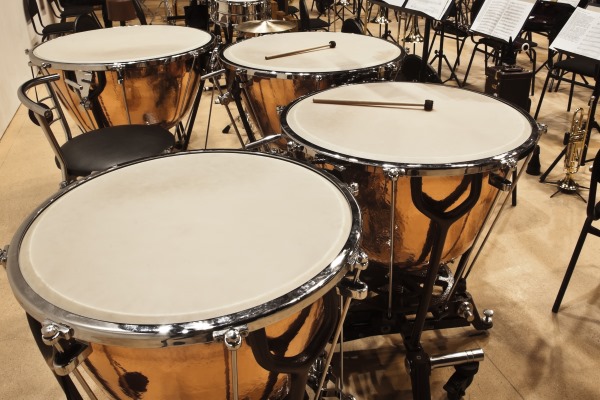The acoustics of kettledrums

Kettledrums (a.k.a. tympani) produce a definite pitch, but in theory they should not. At least the simplest mathematical model of a kettledrum would not have a definite pitch. Of course there are more accurate theories that align with reality.
Unlike many things that work in theory but not in practice, kettledrums work in practice but not in theory.
A musical sound has a definite pitch when the first several Fourier components are small integer multiples of the lowest component, the fundamental. A pitch we hear at 100 Hz would have a first overtone at 200 Hz, the second at 300 Hz, etc. It's the relative strengths of these components give each instrument its characteristic sound.
An ideal string would make a definite pitch when you pluck it. The features of a real string discarded for the theoretical simplicity, such as stiffness, don't make a huge difference to the tonality of the string.
An ideal circular membrane would vibrate at frequencies that are much closer together than consecutive integer multiples of the fundamental. The first few frequencies would be at 1.594, 2.136, 2.296, 2.653, and 2.918 times the fundamental. Here's what that would sound like:
http://www.johndcook.com/ideal_tympani.wav(download)
I chose amplitudes of 1, 1/2, 1/3, 1/4, 1/5, and 1/6. This was somewhat arbitrary, but not unrealistic. Including more than the first six Fourier components would make the sound even more muddled.
By comparison, here's what it would sound like with the components at 2x up to 6x the fundamental, using the same amplitudes.
http://www.johndcook.com/real_tympani.wav(download)
This isn't an accurate simulation of tympani sounds, just something simple but more realistic than the vibrations of an idea membrane.
The real world complications of a kettledrum spread out its Fourier components to make it have a more definite pitch. These include the weight of air on top of the drum, the stiffness of the drum head, the air trapped in the body of the drum, etc.
If you'd like to read more about how kettle drums work, you might start with The Physics of Kettledrums by Thomas Rossing in Scientific American, November 1982.